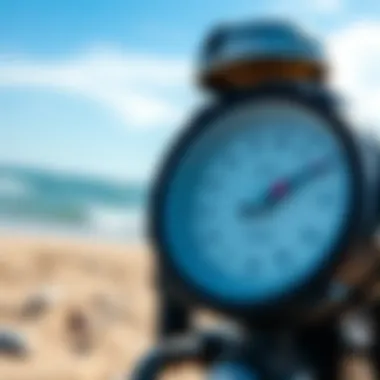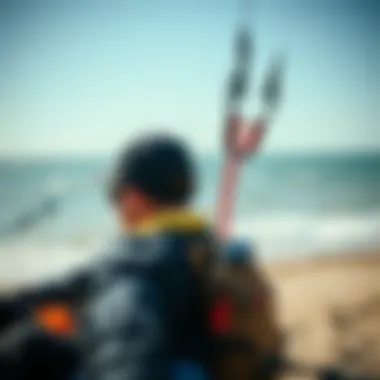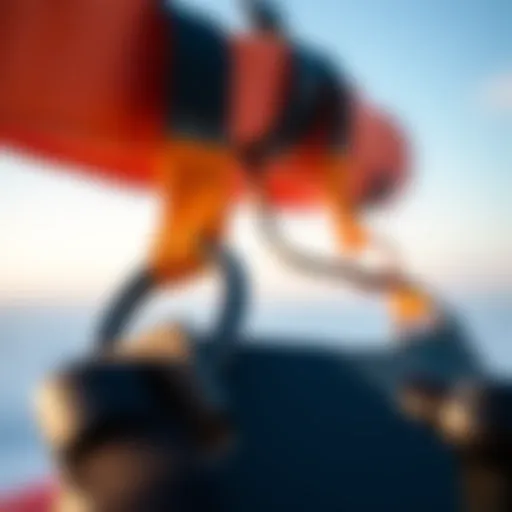Understanding Real Time Wind Gusts for Kiteboarding


Intro
Kiteboarding is not simply about having a good time on the water; it’s an intricate dance between the kite, the rider, and the wind. Understanding real-time wind gusts is essential for kiteboarding enthusiasts, whether you are a novice learning the ropes or a seasoned pro who has been chasing the perfect wind for years.
The wind, in all its unpredictable glory, plays a crucial role in the performance and safety of kiteboarding. Knowing how to interpret wind conditions can shape not only your ride but also your overall experience. In this guide, we will delve into the critical aspects of wind gusts, from what they mean to the tools that can help you measure them.
From gear to techniques, understanding these elements can empower kiteboarders to make informed decisions on when and where to hit the waves. Let’s take a deeper look into the world of wind gusts and their importance in kiteboarding.
Gear and Equipment
When kiteboarding, the right gear can make or break your session. Not just any kite or board will do; the equipment must be suited to the specific wind conditions you are facing. So, let's break down the essentials.
Essential Kiteboarding Gear: A Comprehensive Guide
- Kite: This is the heart of your kiteboarding setup. Depending on the wind conditions, you might choose a larger kite for lighter winds and a smaller kite for stronger gusts. Brands like Naish and Cabrinha offer a range of models.
- Board: Different boards cater to various styles. A twin-tip board will provide the versatility to ride comfortably in multiple conditions, while a directional board can enhance performance in surf.
- Harness: A well-fitted harness is key. You want one that allows for freedom of movement yet gives you the support needed to hold onto your kite comfortably. a waist harness is often preferred for its lower profile.
- Lines: Always check your lines for wear and tear. They are crucial for connecting your kite to the control bar, and keeping them in top condition is non-negotiable.
- Safety Equipment: Don’t forget about a helmet and a buoyancy aid. Safety should never take a back seat, so gear up before you hit the water.
Maintenance Tips for Kiteboarding Equipment
Taking care of your gear plays an important role in kiteboarding. Here are some key maintenance tips:
- Rinse with Fresh Water: After each session, rinse your kite and lines to remove salt or sand that could cause damage.
- Proper Storage: Store your kite in a cool, dry place, avoiding direct sunlight to prevent UV damage.
- Regular Check-ups: Inspect your gear before every outing; damaged lines or worn fabric can lead to accidents.
- Repairs: Be proactive about repairs. Patching small tears and replacing worn components could save you from bigger headaches later.
“An ounce of prevention is worth a pound of cure.” - Benjamin Franklin
Keeping your equipment in great shape not only extends its life but also enhances your safety and performance on the water.
Techniques and Skills
Mastering wind dynamics goes beyond the right gear. It involves honing your techniques and skills to adapt to varying conditions.
Beginner Techniques to Get Started with Kiteboarding
For those just starting, understanding wind gusts is fundamental. Here are a few beginner tips:
- Learn to Gauge Wind Strength: Use simple tools like an anemometer to measure wind speeds. This can help you understand your limits.
- Practice Wind Direction Awareness: Always be mindful of how the wind's direction affects your kite's performance. Learning to read the wind can make or break your day.
- Body Position: Keep your body low and your weight centered during gusts. This helps maintain control and stability.
Advanced Maneuvers for Seasoned Kiteboarders
Once you are familiar with the basics, it’s time to elevate your game. Advanced riders can benefit from understanding gust management more finely:
- Use Kite Power Efficiently: In strong gusts, angle your kite more downwind to harness power effectively without being overpowered.
- Jumping in Gusty Conditions: Knowing when to pull up on your bar during a gust can give you lift, allowing for higher jumps.
- Transitioning Smoothly: In fluctuating winds, practice transitioning between different stances to maintain momentum and control as the wind dies down or kicks up.
In sum, understanding real-time wind gusts and mastering the corresponding skills can significantly enhance your kiteboarding adventures, allowing for a safer and more exhilarating experience on the water. As you engross yourself in the mathematical nuances of wind dynamics, your riding will surely take flight.
Intro to Wind Dynamics
Wind is an invisible force, yet its impact on various activities—especially kiteboarding—is undeniable. Understanding the dynamics of wind, particularly real-time gusts, is crucial for kiteboarding enthusiasts. A deep dive into how wind behaves can make the difference between an exhilarating session on the water and a hazardous experience.
Real-time wind gusts refer to sudden, brief increases in wind speed that can significantly affect kite performance. As kiteboarders glide across the water, varying gusts can lead to unexpected changes in direction and speed.
What are Real Time Wind Gusts?
Real-time wind gusts are changes in wind speed that occur within a very short time frame, typically measured in seconds. These gusts are critical for kiteboarders, as they can range from subtle increases to sudden bursts that alter the kite's lift and handling characteristics.
Imagine you’re kiteboarding, soaring through the air, when suddenly a gust hits unexpectedly. Your kite might pull hard or drag you forward, with little time to react. Understanding these gusts can help kiteboarders anticipate and adjust their movements, ultimately enhancing safety and performance.
Factors contributing to wind gusts include environmental conditions, geographical features, and changing weather patterns. Learning to identify these factors allows kiteboarders to better prepare for varying wind conditions, resulting in a more enjoyable experience on the water.
Importance of Wind in Kiteboarding
Wind serves as both the engine and the dance partner in kiteboarding. It propels the kite, drives the rider across the water, and provides the lift necessary for aerial tricks. Without suitable wind, kiteboarding wouldn't be feasible.
For kiteboarders, understanding the nuances of wind can significantly enhance their performance. Here are several key points to consider:


- Lift Generation: Kites rely on wind to generate lift. A solid grasp of gust dynamics enables riders to harness this lift more efficiently.
- Navigating Conditions: Different wind strengths provide varying riding experiences. Some may prefer heavier winds for challenging tricks, while others may seek gentler breezes for leisurely cruising.
- Safety First: By recognizing wind patterns and potential gusts, kiteboarders can make informed decisions, reducing accidents and ensuring a safer ride.
Having this awareness not only improves overall performance but also cultivates greater confidence in the water. Kiteboarding isn’t merely about comfort on the surface; it requires a synergy with wind dynamics to fully master the sport.
"Understanding wind gusts can transform a ride into an experience, turning challenges into triumphs."
In summary, mastering the dynamic behavior of wind gusts is essential for any kiteboarder aiming to elevate their skills. Not only does this knowledge unfold more enjoyable sessions, but it also lays a foundation for safety and adaptability in an ever-changing environment.
Factors Affecting Wind Gusts
Understanding wind gusts is crucial for kiteboarding enthusiasts. The strength and behavior of wind can dictate the success or failure of a session on the water. Factors affecting wind gusts are multidimensional; they intertwine geographical features, seasonal changes, and local terrain. Each aspect plays a role in shaping the experience of kiteboarding, from how a rider maneuvers their board to the choice of equipment. Let's break it down into three significant influencing factors: geographical influences, seasonal variations, and local terrain effects.
Geographical Influences
The location where one chooses to kiteboard can greatly affect wind patterns. Coastal areas, for example, often present a very different experience than inland spots.
- Coastal Winds: Near the shoreline, the wind patterns are generally steadier due to the unobstructed flow of air over water. As the sun heats the land, air rises, and cooler air from the sea rushes in to take its place, creating reliable onshore breezes.
- Inland Complexities: In contrast, inland locations can see the wind shifting unexpectedly as buildings or trees disrupt the air flow. Riders need to be adaptive; practicing in a more variable wind environment requires keen observation and a strong understanding of how the local geography can change everything.
By being mindful of these geographical elements, kiteboarders can better anticipate the wind's behavior, and thus enhance their overall experience.
Seasonal Variations
Mother Nature has her own rhythm, and understanding seasonal wind patterns can be a game-changer for kiteboarders.
- Spring and Summer: Generally, these seasons bring more consistent winds, but the intensity can vary widely. Warmer days often produce stronger gusts as thermal winds develop. Kiteboarders may benefit from planning sessions during afternoons when thermal winds are at their most reliable, leading to exhilarating rides.
- Autumn and Winter: Conversely, these seasons can be a mixed bag. Temperatures drop, and while some locations may experience storm systems bringing strong winds, others might see sporadic gusts. Riders need to stay informed and flexible, adjusting plans according to the day’s specific wind conditions.
By tracking these seasonal changes, kiteboarders can align their riding schedules with optimal wind patterns, making for more enjoyable outings.
Local Terrain Effects
While wind speed and direction may be influenced by broader geographical and seasonal factors, local terrain can introduce additional complexities. This can include:
- Obstacles: Trees, buildings, or cliffs can cause turbulence or wind shadow areas. When wind meets obstacles, its speed can drop suddenly or change direction unpredictably. Riders should scout the area for any attractive nuisances.
- Surface Features: Hills or valleys can funnel the wind, creating pockets of stronger gusts. For instance, riding in a valley might lead to unexpected lulls in wind intensity when crossing from open areas.
Being aware of local terrain allows kiteboarders to fine-tune their techniques and equipment choices, thus optimizing their kiteboarding experience.
"The wind can be as unpredictable as a cat on a hot tin roof, and understanding these influences helps kiteboarders stay ahead of the curve."
Measurement of Wind Gusts
Understanding the measurement of wind gusts is essential for kiteboarding enthusiasts. Wind gusts can dramatically affect your performance and safety while riding. They can be unpredictable, shifting quickly and presenting challenges that require instant adaptation. Accurate measurement allows kiteboarders to plan their sessions more effectively and enjoy a safer experience on the water.
Instruments Used for Measurement
When it comes to measuring wind gusts, several instruments come into play. Here's a rundown of the tools that can help:
- Anemometers: These gadgets can be hand-held or installed permanently at a location. They measure wind speed and direction, providing both average speeds and peak gusts in real time. Modern digital anemometers often have screens displaying vital info at a glance.
- Weather Stations: Many kiteboarders invest in personal weather stations. These devices collect data not just on wind, but also temperature, humidity, and pressure, offering a comprehensive view of the weather conditions.
- Smartphones: Various apps can utilize built-in sensors to give wind readings based on your location. While not as precise as specialized devices, they offer a quick way to check the weather before heading out.
- Remote Sensors: Some advanced setups incorporate remote sensors placed at different heights to measure disparities in wind currents. This is particularly useful for understanding turbulence and planning the best times to ride.
Using these instruments provides kiteboarders with accurate data, helping to enhance both performance and safety.
Understanding Wind Speed Readings
Grasping how to read wind speed data is crucial for kiteboarders. This includes not only knowing the numbers but also comprehending their significance. Wind speed is usually measured in meters per second (m/s) or miles per hour (mph). Here are some key points to keep in mind:
- Gust Speeds vs. Average Speeds: Keep in mind that wind gusts might peak far higher than the average wind speed. A reading like 12 mph may indicate that there’s a maximum gust hitting 20 mph—this is vital information when selecting the right kite size and adjusting your riding technique.
- Be Mindful of Variations: Different tools may report varied readings based on factors like location, height, and immediate terrain. Always consider these aspects when analyzing data.
- Comfort Zones: Different kiteboarders have different comfort levels with gusts. For a beginner, gusts over 15 mph can shift from exhilarating to daunting quickly. Experienced kiteboarders may thrive in gusty conditions but should always remember that safety isn't something to take lightly.
By understanding wind speed readings and the instruments at hand, kiteboarders can paint a clearer picture of what to expect on the water. This knowledge can be the difference between an enjoyable session and a challenging one, allowing for better preparation and adjustments.
Real Time Wind Data Sources
Having access to accurate and up-to-date information about wind conditions can make the difference between a thrilling session on the water and a regrettable day spent stuck on the shore. Understanding real-time wind data sources is vital for any kiteboarder looking to optimize their time on the water. By leveraging these sources, kiteboarders can better anticipate wind changes, plan their sessions effectively, and align their riding techniques with current conditions. In this section, we’ll explore two key resource categories: weather stations and online tools, alongside mobile applications specifically designed for kiteboarding enthusiasts.
Weather Stations and Online Tools
Weather stations play a crucial role in collecting reliable data regarding wind speed and direction. They are often strategically placed at various locations such as coastal areas, parks, or recreational spots. These stations are equipped with anemometers, which measure wind speeds precisely, as well as other meteorological instruments that track temperature, humidity, and atmospheric pressure.


Here are some benefits of using weather stations and online tools:
- Real-Time Data: Most weather stations provide live updates, allowing kiteboarders to make on-the-spot decisions about whether to hit the water.
- Historical Data Access: Many online platforms archive wind data, which can assist riders in identifying trends and patterns in wind conditions over time.
- Local Insights: Some tools aggregate reports from multiple users, providing a comprehensive view of wind conditions in a specific area.
Popular websites for kiteboarders looking to access real-time wind data include windfinder.com and kitetoolbox.com. These platforms not only list current wind conditions but also forecast future gusts, making it easier for enthusiasts to prepare.
"Understanding wind conditions can truly elevate your kiteboarding experience. The right information can transform a mediocre outing into the highlight of the week."
Mobile Applications for Kiteboarders
In the age of smartphones, mobile applications bring wind data directly to users’ pockets. These apps are particularly useful for kiteboarders who are often on the move or at various locations.
Some notable features of kiteboarding mobile applications include:
- Instant Notifications: Apps can alert users to changing wind conditions and weather updates, ensuring that kiteboarders don’t miss out on ideal riding conditions.
- Community Engagement: Many apps allow users to share their experiences and local conditions, fostering a community of kiteboarding enthusiasts who help one another.
- Geolocation Services: Some applications use GPS to provide localized data, giving kiteboarders real-time insights based on their specific location.
Apps such as Windy and Kitesurfing Spots are excellent choices for those looking for tailored wind data without having to sift through irrelevant information.
For any kiteboarder, awareness of real-time wind data sources—whether through weather stations and online tools or mobile applications—empowers them to make informed decisions that can enhance their riding experience significantly.
Wind Gust Impact on Kiteboarding
Kiteboarding is a sport driven by the wind, and understanding wind gusts can mean the difference between a thrilling ride and a disastrous one. Real-time wind gusts significantly influence a kiteboarder’s experience—affecting not only the safety of the riders but also their performance on the water. By diving deep into the implications of wind gusts, both novices and seasoned kiteboard enthusiasts can vastly improve their sessions, whether they're catching air or simply cruising along the shoreline.
Safety Considerations
When tackling the waters, safety should always be the top priority. Wind gusts, which can change drastically in a matter of moments, present unique hazards for kiteboarders. Strong gusts can cause the kite to lift uncontrollably, making it difficult to maintain control.
Here are some key safety considerations to keep in mind:
- Know Your Limits: Understanding how different wind strengths affect your control and handling is crucial. If you are a beginner or not entirely comfortable with your kite, steer clear of excessive gusts.
- Monitor Wind Patterns: Regularly check for fluctuations in wind speed and direction. Staying aware of sudden gusts can prevent accidents—like being pulled off balance, potentially leading to falls.
- Use Proper Gear: The equipment you choose plays a significant role in your ability to handle strong gusts. Opting for kites specifically designed for high wind speeds can enhance your stability and ensure a safer ride. It's also wise to wear safety gear, such as helmets and impact vests, in breezier conditions.
"Ignoring the impact of wind gusts is like sailing a boat without a compass; you might find your way, but it sure won't be smooth sailing."
Performance Enhancement
Wind gusts don’t only come with risks; they can also enhance your performance if wielded wisely. After all, massive air and thrilling rides are often the product of understanding and adapting to wind dynamics. Here’s how kiteboarders can leverage gusts to their advantage:
- Jump Higher: When timed correctly, wind gusts can give you the lift you need to achieve greater heights. Learning to read gust patterns allows you to time your jumps for maximum elevation.
- Speed Boosts: Gusty conditions can fill your kite with extra power, translating to faster speeds. Adjusting your riding style to embrace the wind's energy lets you cut through the waves like a hot knife through butter.
- Tricks and Maneuvers: More experienced riders often use gusts to execute advanced tricks. The added power can facilitate twists and flips—transforming an ordinary session into a showcase of skill and capability.
Techniques for Adapting to Wind Conditions
Wind conditions can be as fickle as a cat on a hot tin roof, changing at a moment's notice. Kiteboarding, being so intertwined with these variable elements, requires riders to adapt swiftly and effectively. Mastering the art of responding to wind conditions is not just about enhancing performance; it’s about safety and enjoying the ride.
Adjusting Kite Size and Type
Choosing the right kite size and type depends significantly on the wind's intensity and gust level. A smaller kite in strong winds can prevent overloading and loss of control, while a larger kite in lighter conditions will keep you flying.
- Consider the wind force: Wind speed and gustiness can fluctuate greatly in just minutes. Direction and consistency also play crucial roles. For example, if it’s blowing a steady 15 mph, a medium-sized kite may do the trick. However, when gusts kick in, consider a size adjustment.
- Wind conditions: Check for signs like flag movements or visual indicators in the water. If you notice strong gusts causing the small waves to crest sharply, it might be time to downsize your kite.
- Kite type: Different types of kites suit various conditions. Freeride kites often boast stability, making them ideal for stronger winds. On the flip side, freestyle kites provide more agility in lighter winds. Understanding when to deploy one over the other comes with experience, but each trip out can be a learning opportunity.
"The right kite can turn a difficult session into a dream ride, while the wrong one can land you in a pickle."
Riding Techniques for Different Gust Levels
Adapting your riding technique according to gust levels is equally critical. Gusts can vary widely in intensity, requiring you to hone in on your skills.
- Moderate Gusts (10-15 mph): In these conditions, maintaining steady pressure and control is vital. Employ a smooth edge while transitioning to avoid lets of sudden pulls from your kite.
- Strong Gusts (15-25 mph): Here, the need to mitigate abrupt kite movements becomes crucial. Lower your center of gravity and keep your weight balanced. This will enhance stability and assist in managing those surges.
To sum up, adapting to wind conditions in kiteboarding isn't just a skill; it’s an essential part of the sport. Kite size variability and technique adjustments can make the difference between an exhilarating jaunt over the water and a harsh struggle against nature. Stay sharp, remain aware, and engage actively with the environment for a consistently enjoyable experience.
Forecasting Wind Gusts
Forecasting wind gusts is a critical component for kiteboarders looking to maximize their performance on the water. Understanding how to predict these changes in wind speed allows kiteboarders to make informed decisions about when and where to ride. This is especially vital, as wind gusts can be unpredictable and vary widely in intensity. Knowing the differences between short-term and long-term forecasts can be the difference between a thrilling session and a harrowing experience.


Short-Term vs Long-Term Forecasts
When discussing forecasting, it’s like comparing apples to oranges. Short-term forecasts generally cover the next few hours to a day, offering real-time insights. They can help kiteboarders spot immediate wind changes, but they might not account for larger weather patterns.
On the other hand, long-term forecasts offer a broader look at weather trends over days or even weeks. While helpful for planning larger kiteboarding trips or vacations, they may miss nuanced daily patterns that can affect sailing conditions significantly.
- Short-Term Forecast Advantages:
- Long-Term Forecast Advantages:
- Real-time updates provide quick adjustments to plans.
- Help gauge on-the-spot conditions.
- Useful for spontaneous kiteboarding sessions.
- Helps in planning trips based on seasonal wind trends.
- Offers insights into broader weather patterns.
- Aids in gear selection for future sessions.
Both types of forecasts have their weaknesses. Short-term forecasts may fail due to sudden climatic shifts, while long-term forecasts can misrepresent the day-to-day variability in wind conditions.
Using Forecasts for Planning Sessions
Utilizing forecasts effectively means understanding how to interpret the data in relation to individual skills, gear, and local conditions. This approach can make every kiteboarding session not just possible but enjoyable. Start by checking your preferred weather sources regularly. Here are some tips to effectively use forecasts:
- Identify Reliable Sources: Websites like NOAA (www.noaa.gov) or Weather Underground (www.wunderground.com) provide good data about local wind patterns.
- Utilize Mobile Apps: Applications such as Windy or Windfinder bring forecasts right to your pocket, allowing on-the-go planning.
- Match Conditions with Skill Levels: Not every kiteboarder thrives in strong gusts. Knowing your limits and adapting to the forecast is crucial for safety and performance.
- Stay Connected with Community: Engage with fellow kiteboarders through platforms like Reddit or local Facebook groups to share insights and personal experiences concerning forecast accuracy.
Here's what you might also consider:
- Gear Selection: Check the wind forecasts and match your kite type accordingly. Smaller kites are better for high winds, while larger kites suit lighter conditions.
- Timing of sessions: Look for times when weather forecasts show a consistent wind. Avoiding those gaps and intense fluctuations can enhance enjoyment and safety.
"The key to successful kiteboarding lies not just in technique, but in the ability to predict and adapt to the whims of nature."
By actively applying forecasting insights, kiteboarders can elevate their experience significantly.
For learning more about practical applications of these concepts, check out the National Weather Service's resources at weather.gov for professional insights and guidelines.
Community Insights and Experiences
Engaging with the kiteboarding community can benefit both novice and seasoned riders. Kiteboarding is not merely about hitting the waves; it’s a shared adventure, and every kiteboarder has stories and strategies that could enhance your experience. By tapping into community insights, one can gain valuable knowledge that goes beyond theoretical understanding and into practical applications. Real-time weather conditions, board setups, preferred spots, or even local regulations—all of these tidbits come directly from the experiences of fellow enthusiasts. This collaboration often leads to improved safety and performance on the water.
Sharing Wind Conditions and Tips
Every kiteboarder knows that wind can switch gears quicker than a cat on a hot tin roof. One moment, the conditions are perfect; the next, you’re battling gusts that send you soaring.
So, having a network to share wind conditions is invaluable. Consider joining local kiteboarding forums or using social media groups where enthusiasts post about current wind states using apps like Windy or PredictWind. Here’s how this sharing culture plays out:
- Real-Time Updates: Members can report live updates, providing insight into whether it’s go-time or pack-it-up.
- Gust Observations: Kiteboarders often discuss gust patterns, their effects on ride quality, and the gear adjustments necessary to manage them.
- Hotspots: Local spots favored for specific wind conditions often become common knowledge through community discussions.
With such information readily available, riders can make informed decisions about when and where to kite. A post saying “Remember to brace for a sweep in the afternoon gusts” can save you from getting caught off-guard.
Learning from Fellow Kiteboarders
There's something to be said for the learning curve that comes with kiteboarding. It can feel a bit like trying to learn how to ride a bike on a rocky hill—sometimes you tumble, but the real magic is in the stories shared amongst peers.
By learning from others, you can:
- Avoid Pitfalls: Experienced kiteboarders can share what not to do, from gear mishaps to techniques that didn’t pan out well.
- Receive Gear Recommendations: Get insights into the best kites and boards suited for particular wind conditions or profiles. What might seem like a hefty investment can pay off greatly if informed by someone who’s already trodden that path.
- Perfect Your Techniques: Simple tips can vastly improve your performance. For example, someone might suggest angle adjustments for a kite to harness wind gusts more efficiently.
"The advice I got from a seasoned rider turned my approach to kiteboarding around. Little tweaks made all the difference in handling different wind conditions."
Whether it's on forums like reddit.com/r/kiteboarding or directly during meet-ups, learning from fellow kiteboarders helps build confidence and enhances safety, allowing for a much more enjoyable time on the water.
Finale
As kiteboarding enthusiasts, understanding real-time wind gusts is not merely a matter of convenience; it’s a necessity for ensuring a safe and enjoyable experience on the water. Knowledge of wind dynamics enables riders to make informed decisions about when and where to kiteboard. This critical appreciation of wind conditions might significantly enhance both safety and performance.
Summarizing the Importance of Wind Awareness
Being aware of wind patterns and gust behavior can lay the groundwork for exciting kiteboarding sessions. For example, when you recognize that wind can pick up abruptly due to terrain or local features, you’re better positioned to adapt your approach. A gust might wind up helping you achieve greater heights with your jumps or, conversely, it could turn into an unexpected predicament if you’re caught off guard. The bottom line is that understanding wind dynamics translates to a higher level of control. Indeed, kiteboarding in different conditions can feel like a dance — one that requires knowing not just the rhythm, but also the tempo.
Encouraging Continued Learning
Wind conditions are not static; they evolve with seasons, geography, and even within a single day. Therefore, continued learning about these variables can greatly benefit every kiteboarder, from seasoned riders to newcomers. It might be worth your while to engage with local kiteboarding communities, either online through platforms like Reddit or in person at nearby beaches.
Consider participating in workshops or training sessions focused on weather patterns and advanced wind forecasting techniques. Embracing a mindset of curiosity and exploration can not only enhance individual skills but also foster a community of well-informed kiteboarders who can share valuable tips and insights.
In the end, skills sharpened through knowledge and experience can elevate fundamental kiteboarding practices into an art form. So, take that initiative to delve deeper into wind dynamics. The sky is, quite literally, the limit.















